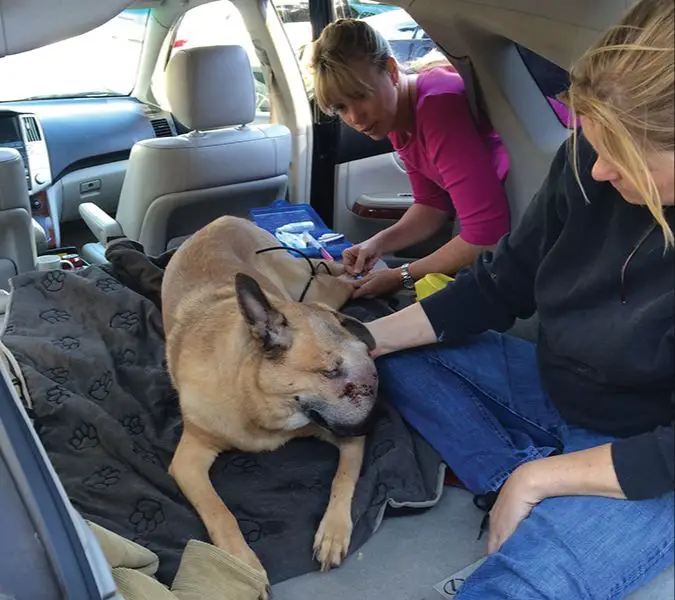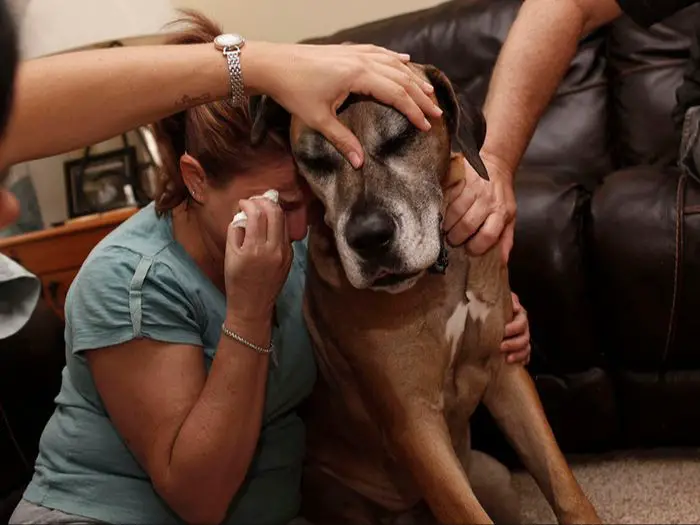Making the Difficult Decision
Deciding to euthanize your beloved dog is one of the most difficult decisions a pet owner faces. There are several reasons owners may choose this heartbreaking option:
– Age – As dogs reach their senior years, age-related diseases like arthritis, cancer, kidney failure become more common. Treatment options become limited and quality of life diminishes. Euthanasia may be the most humane choice.
– Illness – Acute or chronic illnesses like cancer, organ failure, infections can cause unmanageable pain and suffering. If treatment is unsuccessful or not advised, euthanasia spares the dog further distress.
– Injury – Severe injuries from accidents or trauma may result in uncontrollable pain or disability. If the injury is untreatable, euthanasia may be the only way to prevent suffering.
– Behavior problems – Unmanageable aggression, separation anxiety, or other problematic behaviors can make a dog dangerous or destructive. If behavioral therapy fails, euthanasia may be considered.
– Cost of care – Extensive veterinary treatment for complex health issues can become financially burdensome. If funds run out, euthanasia may be the only viable option.
While emotionally painful, choosing euthanasia can be the ultimate act of love and compassion when a dog’s quality of life declines severely.
The Euthanasia Process
The euthanasia process involves giving the dog an overdose of an anesthetic drug, usually sodium pentobarbital. This stops the dog’s heart and breathing, resulting in a peaceful and painless passing away. There are two main types of euthanasia:
Veterinary euthanasia – This is done at the vet’s office. The vet will insert a needle into the dog’s vein and inject the sodium pentobarbital. Death usually occurs within seconds. This allows you to be present during the process if you choose.

At-home euthanasia – A vet will come to your home to perform the euthanasia. This allows your dog to pass away in a familiar environment, which may be less stressful. The vet will give your dog an initial sedative shot followed by the euthanasia injection.
In most cases, vets recommend the veterinary euthanasia option if possible, as they are better equipped to handle any unexpected reactions. However, at-home euthanasia provides a more comfortable setting for your dog’s last moments.
Benefits of Being Present
Being present for your dog’s euthanasia can provide comfort to your companion in their final moments. Your dog has been by your side through life’s joys and challenges. Being there with them at the end can help ease any anxiety or fear they may feel in an unfamiliar setting.
It also gives you a chance to say goodbye. You can offer soothing pets, kind words, and reassurance as your dog passes. This final act of love and support can bring closure. It provides an opportunity for you to express your gratitude for the bond you shared.
Potential Drawbacks
Though being present with your dog during euthanasia can provide comfort, there are potential drawbacks to consider. The most significant is that it can be very emotionally difficult and traumatic to witness your pet’s passing. Dogs may exhibit fear, anxiety or struggle during the process which can be heartbreaking for owners to see. There is a chance your dog may pass away less peacefully than you envisioned, and this experience may stay with you.
The euthanasia process can sometimes involve restraining your dog, inserting the IV catheter, or other clinical aspects that may be upsetting. Watching the life leave your pet’s body can be an emotionally scarring image. While your intention may be to be there for your dog, the reality can end up being quite painful. Some find that staying causes more grief and trauma than comfort.
Additionally, not all veterinarian offices may allow owners to be present. So if witnessing your pet’s passing is very important to you, be sure to find a vet that accommodates this. There can also be extra fees involved.
Ultimately you will need to weigh your own mental health and emotional state when deciding if it is right to be present. For some owners, the extra pain is worth it to honor their pet’s life through being there to the very end. For others, it may be too traumatic of an experience.
Making a Decision
The decision to stay with your dog during euthanasia is a very personal one. There are several factors to consider when deciding what will feel most comfortable and comforting for both you and your pet during this difficult process.
First, think about your dog’s unique temperament and level of attachment to you. An anxious dog that feels most secure in your presence may benefit from having you there for reassurance. On the other hand, a very stoic dog that doesn’t rely heavily on you for comfort may be indifferent to your presence. You know your dog best, so go with your gut feeling about what they would prefer.
Your own emotions are also an important consideration. Witnessing euthanasia can be an incredibly meaningful but also traumatic experience. If you feel you would be too distraught to handle this, there is no shame in waiting outside. While most vets allow owners to be present, some may recommend you step out if your grief prevents them from performing the procedure properly.

There are options like staying just until your dog is sedated so you can comfort them as they drift off. But you do not have to stay all the way through the euthanasia if it would be too difficult for you.
This very personal decision requires honest self-reflection about what feels right for both you and your beloved pet as you start this final journey together.
Preparing Yourself
The decision to euthanize your dog is incredibly difficult. Fully thinking through the process and your possible reactions is essential.
You want to walk into this in as healthy and supported a headspace as possible. Consider having a close friend, family member or even your vet’s office offer to be present as your support person. This person can help by driving you to and from the appointment, providing emotional support during the procedure, and being there for you afterwards.
Take time to consider how you might react during and after the process. Will you want privacy immediately after? Having a plan in place for the hours and days following the loss can help reduce some of the stress and uncertainty.
It may also help to speak with someone who has experience with this process. Your veterinarian should be able to provide guidance, as well as connect you with additional counseling resources and pet loss support groups, if requested.
Preparing Your Dog
To make your dog’s last day as enjoyable as possible, keep things calm and fun. Avoid taking them to crowded places that may cause anxiety or stress. Instead, spend quality one-on-one time together in a relaxing environment.
Make sure to feed them any favorite foods they enjoy. Cook them a special meal if you can. Give them any treats they love, even in excess. This allows them to indulge in their favorite foods.
Consider taking them to places they love – this may be a trip to the park, the beach, the woods, or any spot they particularly enjoy. Make it a positive day full of affection, play, and their favorite activities.
Pamper them with a bath, brushing, petting, or a massage so they feel calm and cared for. Help them feel comfortable and relaxed leading up to their final vet visit.
During the Process
The actual process of euthanasia is usually very peaceful, with minimal discomfort for your dog. The vet will give the injection, often starting with a sedative to relax your dog. Your dog will slowly become unresponsive and drift into unconsciousness before their breathing and heart stop.

You can help comfort your dog during this time by:
- Petting or stroking them gently
- Talking softly to reassure them
- Avoiding sudden movements or distractions
Take the opportunity to say a heartfelt goodbye, give praise and thanks for the joy they brought you. But try to remain calm and avoid emotional outbursts which may distress your dog.
Focus on keeping your dog as comfortable, relaxed and stress-free as possible. The actual passing is generally quick and peaceful. Your vet will confirm when it is complete.
After Euthanasia
After your dog has been euthanized, you will need to decide on final arrangements. Many pet owners choose cremation or burial. Cremation allows you to keep your dog’s ashes or scatter them in a meaningful place. Burial lets you have a gravesite to visit and decorate. Check with your veterinarian or local pet services for options.
The grieving process is difficult but important. Give yourself time to fully experience and process your emotions. Don’t feel rushed. Your pet was a beloved member of your family for years, so grief can feel overwhelming. Be patient and kind to yourself as you mourn. Reach out to friends, family, pet bereavement hotlines, or support groups.
Consider creating a memorial to help honor your dog’s memory. Ideas include assembling a photo album or memory book, planting a tree, creating a special garden space, or making a donation to an animal charity. Do what feels meaningful and comforting for you during this challenging time.
Coping With Loss
Losing a beloved dog is incredibly difficult. Give yourself time to grieve, and don’t feel like you need to “get over it” right away. The depth of the human-animal bond is profound. Honor that bond by allowing yourself to fully experience the emotions that arise. Cry when you need to. Talk to others about your dog. Look through old photos and videos. All of these actions can help you process through the pain.
When you’re ready, start focusing on all the happy memories you shared with your dog. Remember the joy and love you provided for each other. While the end was heartbreaking, treasure the many years of companionship you had. Your dog knew how much you cared every day of its life.

Consider having a memorial for your dog with family and friends. Share stories and remember the special quirks that made your dog unique. Make a donation to an animal shelter or rescue organization in your dog’s honor. Do something your dog loved as a tribute, whether going on a hike, eating a special treat, or playing with a favorite toy. Find ways to honor your dog’s memory that feel meaningful to you.
Losing a pet is devastating. Be gentle with yourself as you mourn. With time, the pain will lessen, and the happy memories will eventually become more prominent than the sad ones. Your dog loved you unconditionally, and you gave your dog the greatest gift of a peaceful, loving end. Though your time together had to end, your love remains.